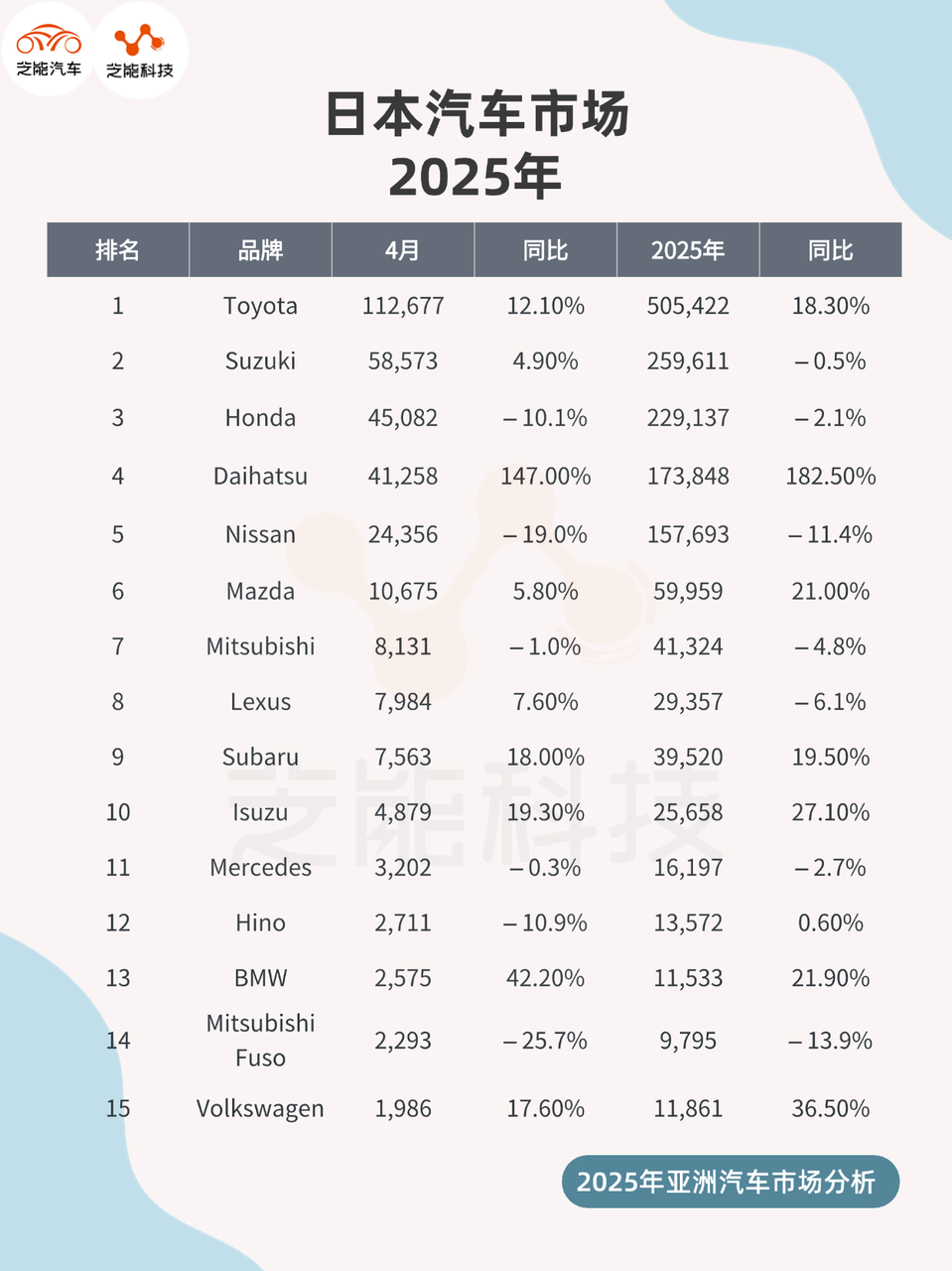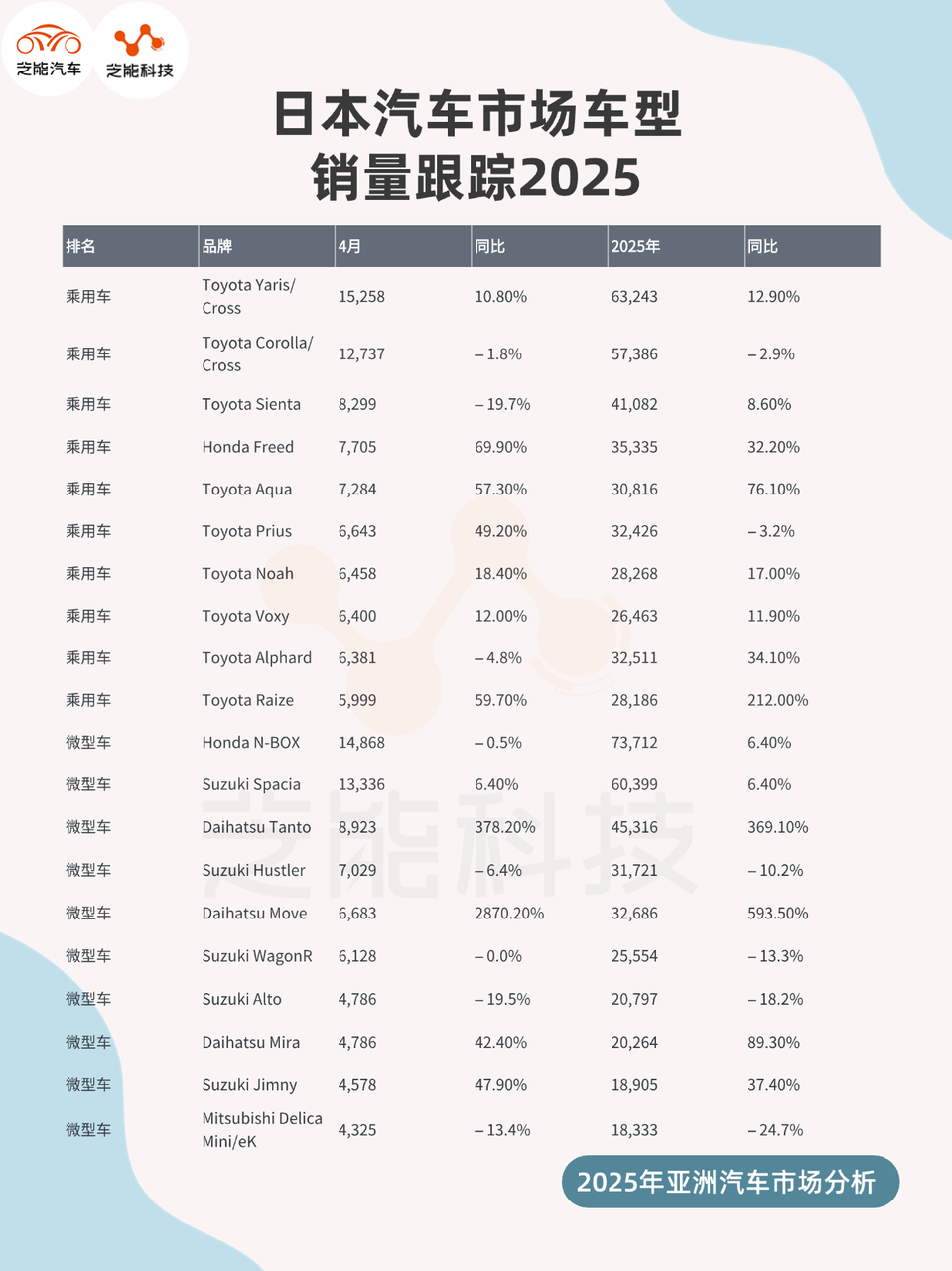Asian Auto Market | April 2025 in Japan: Chinese Brands Navigate Paths to Breakthrough
![]() 05/16 2025
05/16 2025
![]() 604
604

In April 2025, Japan's new car market sustained its recovery trajectory, posting a year-on-year increase of 10.5%, with cumulative sales reaching 1.62 million vehicles.
Domestic brands continue to reign supreme, with Toyota firmly occupying the top spot in conventional car rankings with 11 models, and Daihatsu experiencing remarkable growth. Among foreign brands, German cars excelled. While overall sales of Chinese brands remain modest, they display growth potential fueled by BYD.
In Japan's highly fortified domestic market, Chinese automakers are striving to carve out a niche through product differentiation and brand penetration.
01
Japanese Auto Market's Continued Recovery,
Toyota's Dominance Strengthened,
Fierce Competition in the Light Vehicle Segment
In April, total passenger car sales in Japan reached 342,876 units, marking a 10.5% year-on-year increase. This surge builds on a low base impacted by production disruptions during the same period last year.
Over the first four months of 2025, cumulative sales in the Japanese auto market amounted to 1,628,227 units, up 13% year-on-year.
Amidst the dual forces of electrification and economic recovery, local brands have demonstrated robust market resilience, fostering a highly concentrated market structure.

◎ Toyota's performance remains resilient, with sales of 112,677 units this month, a 12.1% year-on-year increase, and a market share of 32.9%, further expanding from the same period last year, reinforcing its market dominance.
◎ Suzuki ranks second with 58,573 units, up 4.9% year-on-year, slightly edging out Honda's 45,082 units, which declined by 10.1% year-on-year. ◎ Daihatsu experienced a significant rebound with sales of 41,258 units, a 147% year-on-year increase, substantially outpacing Nissan's 24,356 units, which fell by 19% year-on-year.
◎ Isuzu and Subaru recorded growth rates of 19.3% and 18%, respectively, solidifying their positions in the top ten.

At the model level, Toyota's dominance is unmistakable. Eleven of its models rank among the top 12 in conventional car sales, creating an overwhelming advantage.
◎ Yaris/Cross maintains its lead with a 10.8% year-on-year increase, while Corolla/Cross experiences a slight decline.
◎ Roomy sales surged by 339.5%, highlighting the potential of micro MPVs in the local market.
◎ Raize, Aqua, and the new Prius all achieved growth rates exceeding 50%.
◎ Notably, Land Cruiser W grew by 116.3%, reflecting persistent demand for off-road and high-end SUVs among Japanese consumers.
In the light vehicle segment,
◎ Honda N-BOX remains the sales leader, despite a slight year-on-year decline of 0.5%. ◎ Suzuki Spacia increased by 6.4%, firmly holding the second spot. ◎ Daihatsu Tanto emerged as a dark horse, with a 378.2% year-on-year increase, refreshing its market presence. ◎ Additionally, Daihatsu Move surged by 2870.2%, underscoring the strong competitiveness of this product class in the current market structure.
Among imported brands, German brands demonstrated robust growth.
◎ BMW grew by 42.2%,
◎ Mini grew by 40.2%,
◎ Porsche grew by 27%.
◎ Volkswagen and Audi also achieved double-digit growth.
Despite the market's overall concentration on local brands, German brands maintain their growth momentum by leveraging brand power and premium product capabilities.
02
BYD Breaks Through,
Chinese Brands
Still Face Profound Challenges in the Japanese Market
Historically, the Japanese market has posed natural barriers to foreign brands, and Chinese automakers have been progressively advancing their localization strategies in recent years.
In April 2025, BYD's sales in Japan reached 166 units, a 147.8% year-on-year increase. While this figure lags behind local brands and German competitors, it signifies a clear growth trajectory compared to the low base in the same period last year.
As the top-selling Chinese brand in Japan, BYD continues to build brand recognition through pure electric models such as Atto 3 and Dolphin.
In Japan, pure electric vehicles are still not mainstream, with consumers favoring hybrid or light gasoline vehicles. This trend necessitates that for BYD to achieve a sales leap, it must not only localize its technology and channel layout but also adapt to Japanese consumers' aesthetics and driving habits.
Thus far, apart from BYD, other Chinese brands have yet to establish large-scale sales in Japan, with their brand rankings and sales failing to enter the top 30.
Although Japan's electrification trend is gradually advancing, policy guidance, infrastructure, and consumption structures are far from being as mature as in the European market. Consequently, it is challenging for Chinese brands to replicate the explosive growth seen in Norway or the Netherlands in the short term.
From the current structure, the Japanese auto market exhibits exceptionally high brand loyalty. Brands like Toyota, Honda, and Suzuki have built a highly stable user base, relying on a robust sales network and after-sales system, creating barriers that are difficult to overcome.
In contrast, Chinese brands lack effective channel penetration and brand trust locally, overall being at the stage of strategic exploration.
However, with the Japanese government's policy directive to cease selling traditional fuel vehicles by 2035 and support for zero-emission vehicles in major cities like Tokyo, the Japanese electric vehicle market is anticipated to open new opportunities in the coming years.
For Chinese brands, sustained investment in brand building and channel expansion at this stage will lay the groundwork for medium- to long-term penetration.
Summary
The Japanese auto market in April 2025 showcases typical characteristics of a "structural recovery": local brands are stable and rising, light vehicles and hybrids continue to dominate, imported premium brands maintain a stable share, and companies like BYD are entering the market with clear product positioning. Facing Japan's highly mature and closed competitive environment, Chinese automakers must build trust, expand beyond technological channels, and leverage the global electrification trend to steadily advance their strategic deployment in Japan.








